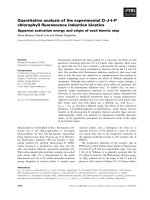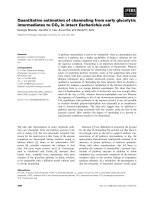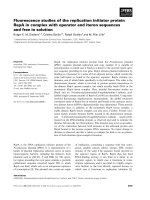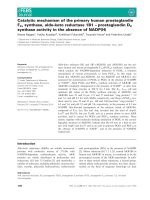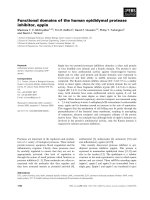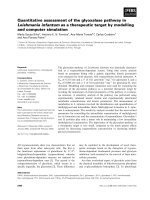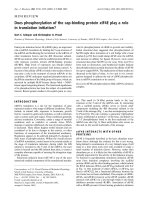Báo cáo sinh học: "Quantitative estimation of genetic risk for atypical scrapie in French sheep and potential consequences of the current breeding programme for resistance to scrapie on the risk of atypical scrapie" pptx
Bạn đang xem bản rút gọn của tài liệu. Xem và tải ngay bản đầy đủ của tài liệu tại đây (595.43 KB, 7 trang )
Genetics
Selection
Evolution
Fediaevsky et al. Genetics Selection Evolution 2010, 42:14
/>Open Access
RESEARCH
BioMed Central
© 2010 Fediaevsky et al; licensee BioMed Central Ltd. This is an Open Access article distributed under the terms of the Creative Com-
mons Attribution License ( which permits unrestricted use, distribution, and reproduc-
tion in any medium, provided the original work is properly cited.
Research
Quantitative estimation of genetic risk for atypical
scrapie in French sheep and potential
consequences of the current breeding programme
for resistance to scrapie on the risk of atypical
scrapie
Alexandre Fediaevsky*
1,2
, Didier Calavas
2
, Patrick Gasqui
1
, Katayoun Moazami-Goudarzi
3
, Pascal Laurent
3
, Jean-
Noël Arsac
2
, Christian Ducrot
1
and Carole Moreno
4
Abstract
Background: Since 2002, active surveillance programmes have detected numerous atypical scrapie (AS) and classical
scrapie cases (CS) in French sheep with almost all the PrP genotypes. The aim of this study was 1) to quantify the
genetic risk of AS in French sheep and to compare it with the risk of CS, 2) to quantify the risk of AS associated with the
increase of the ARR allele frequency as a result of the current genetic breeding programme against CS.
Methods: We obtained genotypes at codons 136, 141, 154 and 171 of the PRNP gene for representative samples of
248 AS and 245 CS cases. We used a random sample of 3,317 scrapie negative animals genotyped at codons 136, 154
and 171 and we made inferences on the position 141 by multiple imputations, using external data. To estimate the risk
associated with PrP genotypes, we fitted multivariate logistic regression models and we estimated the prevalence of
AS for the different genotypes. Then, we used the risk of AS estimated for the ALRR-ALRR genotype to analyse the risk
of detecting an AS case in a flock homogenous for this genotype.
Results: Genotypes most at risk for AS were those including an AFRQ or ALHQ allele while genotypes including a VLRQ
allele were less commonly associated with AS. Compared to ALRQ-ALRQ, the ALRR-ALRR genotype was significantly at
risk for AS and was very significantly protective for CS. The prevalence of AS among ALRR-ALRR animals was 0.6‰ and
was not different from the prevalence in the general population.
Conclusion: In conclusion, further selection of ALRR-ALRR animals will not result in an overall increase of AS
prevalence in the French sheep population although this genotype is clearly susceptible to AS. However the
probability of detecting AS cases in flocks participating in genetic breeding programme against CS should be
considered.
Background
Bovine spongiform encephalopathy (BSE) is a zoonotic
transmissible spongiform encephalopathy (TSE), which
may have spread to sheep and goat populations. This situ-
ation has prompted European countries to organise con-
trol and surveillance of TSEs in small ruminants in which
BSE cannot be clinically distinguished from scrapie.
In sheep, genetic susceptibility to classical scrapie (CS)
is supported by polymorphic variations at codons 136,
154 and 171 of the PRNP gene, which encodes the normal
cellular protein prion (PrP
C
) [1]. The main alleles defined
by these three codons can be classified by increasing risk
as follows ARR < AHQ < ARQ ≈ ARH < VRQ [2]. This
knowledge has made it possible to implement eradication
programmes throughout Europe based on positive selec-
tion of the most resistant allele (ARR) and negative selec-
tion of the most susceptible one (VRQ) [2,3].
* Correspondence:
1
INRA, Centre de Clermont-Theix, 63122 Saint Genès Champanelle, France
Full list of author information is available at the end of the article
Fediaevsky et al. Genetics Selection Evolution 2010, 42:14
/>Page 2 of 7
Recently, an atypical form of scrapie (AS) has been
detected and has challenged such programmes since ani-
mals genetically resistant to CS are affected [4-7]. How-
ever, although it is generally accepted that CS is an
infectious and contagious disease [8], the contagiousness
of AS is questioned. Indeed, the marker specific for AS
disease is not detected outside the central nervous system
[5,9-14], even in cases where AS has been experimentally
transmitted to transgenic mice [15] and sheep [16].
Furthermore, most AS cases have been observed in ani-
mals with genotypes showing low susceptibility to CS.
Several studies have shown that AS susceptibility is
highly associated with PrP codons 141 (L/F) and 154 (R/
H) [17,18]. It is important to note that AS cases have been
detected in ALRR carriers but rarely in VLRQ carriers.
A descriptive study has reported that the estimation of
AS prevalence in Europe is similar, whatever the country
or tested population and amounts to about 6 cases per
10,000 tests. Conversely, CS prevalence appears to be het-
erogeneous both between countries and, within coun-
tries, between fallen stock and healthy slaughter [11].
This could hide a relatively high prevalence of AS in the
most susceptible genotypes. In addition, estimation of the
prevalence of AS in ALRR-ALRR animals is strategically
important to assess the impact of current breeding pro-
grammes on the AS prevalence in the general population.
In France, breeders of flocks participating in breeding
programmes for CS resistance are encouraged to join in a
voluntary scrapie certification scheme, for which it is also
compulsory to send animals to breed selection centres
(Internal circular from French Ministry of Agriculture,
DGAL/SDSPA/N2006-8093). This certification scheme
implies testing all fallen stock over 18 months, which
increases the risk of detecting AS cases in these flocks
compared to general flocks.
We have carried out a case control study by using data
from the TSEs surveillance programme to estimate the
risk of AS associated with the PrP genotypes in the
French sheep population and to compare it with the risk
of CS. In addition, we have used our dataset to estimate
the prevalence of AS per genotype and the risk for a fully
CS resistant flock (100% ALRR-ALRR) to be detected
positive for AS under certain assumptions.
Methods
Selection of cases
Cases were recruited among the animals tested for TSEs
in France from 1
st
January 2002 to 31
st
December 2007.
Each year since 2002, a number of adult (over 18 months
old) sheep from unknown TSE status flocks was ran-
domly selected for TSE detection at abattoirs (healthy
slaughter) or at rendering plants (fallen stock). Details
concerning the French active surveillance programme are
described in Cazeau [19]. Between 2002 and 2007,
859,157 samples were analysed within this programme,
among which 532,500 were tested with the recommended
tests for AS detection [20,21].
All positive samples were confirmed and typed by the
National reference laboratory for animal TSEs of AFSSA
Lyon using EU approved reference methods [22]. For all
positive cases the presence of BSE was dismissed by dis-
criminatory tests; the cases detected with the tests rec-
ommended for AS were typed in order to classify them as
AS or CS; other positive cases were assumed to be CS.
During that period, 404 cases of AS and 395 cases of CS
were confirmed. Among these cases, DNA was available
or could be extracted from the central nervous system
samples kept at AFSSA Lyon for respectively 248 AS and
245 CS cases.
Genotyping of CS and AS cases
During that period, the PrP genotype of all cases was rou-
tinely determined, when suitable samples were available,
at codons 136, 154 and 171 with a technique that could
not differentiate ARH and ARQ alleles. Further analyses
were conducted to specify alleles at position 141 and 171
by the Taq man method [23,24]. It is generally agreed that
this method provides accurate, reproducible and reliable
results. For example, in human large-scale association
studies, the error rate is estimated to be less than 0.3%
[25] or even 0.05% [26]. These analyses were conducted
by the National reference laboratory for PRNP genotyp-
ing (Labogena, Jouy-en-Josas, France) which is certified
for this test by the French standard COFRAC (NF EN
ISO/CEI 17025). PrP polymorphisms at codons 136, 141,
154 and 171 of the 248 AS cases were analysed after
direct sequencing of the coding region of the PRP gene
encompassing codons 92-282. These analyses were con-
ducted by INRA (Jouy-en-Josas, France). For more details
concerning primers and sequencing see [27].
Selection of controls
Controls were recruited among animals that were tested
for the presence of TSEs with a negative result. Controls
for AS were animals tested with one of the tests recom-
mended for the detection of AS and controls for CS were
animals tested with any rapid test.
Genotyping of controls
As a legal requirement [3], during the TSE active surveil-
lance programme 2002-2007, a subset of 3,347 animals
was randomly selected for PrP genotyping. We used this
sample as genotype controls. The genotyping of this con-
trol dataset was conducted by Labogena at codons 136,
154 and 171 with the limits specified before (missing
information for codons 141 and 171). No significant dif-
ference of PrP frequencies at codons 136, 154 and 171
was observed between the present control dataset and
estimates from an external data set of the general French
Fediaevsky et al. Genetics Selection Evolution 2010, 42:14
/>Page 3 of 7
ovine population [27]. In addition, distributions in both
datasets were in Hardy-Weinberg equilibrium. For these
two reasons, we inferred F141 and H171 information
from the external data set to our control data set. In order
to take into account a possible uncertainty on the estima-
tion of F141 and H171 in the external dataset, we consid-
ered that the estimated values for F141 and H171 were
random variables with beta-multinomial distributions
with means and variances equalling those estimated from
the external dataset. Finally, we took into account that
uncertainty in the inference process by bootstrapping
1,000 times the control dataset.
Demographic data
In order to adjust for potential confounding variables, we
collected information on the stream of surveillance
(healthy slaughter/fallen stock) and the dentition of the
animals (2-4 definitive incisors (DI)/5-7 DI/8 DI) which is
a poor proxy for age [28] but was the only information
available. This led to exclude some animals for which
information was missing (two cases of CS and nine con-
trols).
Multivariate analysis
For each type of scrapie, we fitted multivariate logistic
regression models to assess the risk associated to geno-
types with ALRQ-ALRQ as the baseline category,
because this genotype is assumed to be the ancestral gen-
otype. We adjusted the models on the surveillance stream
with healthy slaughter as the baseline category, and on
dentition, with the class corresponding to the youngest
animals as the baseline category. The model outputs were
odds ratio (OR) which can be interpreted as an approxi-
mation of the relative risk in the context of rare diseases.
We could not estimate OR associated with the genotypes
in which no case was detected. The value of the OR and
their 95% confidence intervals for the 1,000 datasets were
computed using the Rubin method [29].
Estimation of prevalence
We estimated the prevalence of AS for each genotype.
Because the proportion of animals genotyped was differ-
ent for cases and controls, we defined it as the national
prevalence (404/532,500 for AS) times the proportion of
the genotype among cases, divided by the frequency of
the genotype in the general population. Using a Bayesian
approach, we considered that each of these proportions
followed a beta distribution with mean and variance esti-
mated by the observations. We derived the median and
the 95% credibility interval of prevalences based on 2,000
iterations obtained after convergence.
Estimation of the probability of case detection at flock level
We have considered the risk for a fully ALRR-ALRR flock
to be detected positive for AS. We assumed that in any
flock the individual risk of AS depended only on the gen-
otype, the age and the surveillance stream. Considering
that the animals tested from a given flock had the same
distribution of age and surveillance stream as the general
population, the average individual risk for an ALRR-
ALRR animal could be estimated by the prevalence previ-
ously estimated for this genotype. Since the occurrence of
AS in a flock was defined as an independent event, the
number of cases in a flock, X, followed a binomial distri-
bution. The probability for at least one animal being AS
positive among n animals tested was:
Using the previous methods to estimate the prevalence
per genotype, we derived the median of the probability
and its 95% credibility interval for n varying from 1 to
1,000, based on 2,000 iterations obtained after conver-
gence.
All the statistical analyses were done with R for Win-
dows [30] and Winbugs [31].
Results
After exclusion of missing information on genotypes and
dentition, 248 AS cases, 245 CS cases and 3,317 controls
were used to estimate OR and prevalence (Table 1). Cases
of CS and/or AS were detected in all genotypes.
There were no AS cases among the ALRR-VLRQ,
ALRQ-ALRH, ALRQ-VLRQ, and VLRQ-VLRQ geno-
types. The ALHQ-ALHQ, AFRQ-ALHQ and AFRQ-
AFRQ genotypes were associated with the highest risks of
AS compared to ALRQ-ALRQ. Within CS cases, the
VLRQ-VLRQ animals presented the highest risk com-
pared to ALRQ-ALRQ. ALRR carriers and to a lesser
extent ALHQ carriers were the most resistant to CS.
The AS prevalence estimates for the most susceptible
genotypes (AFRQ/ALHQ, ALHQ/ALHQ and AFRQ/
AFRQ) were respectively 11, 25 and 31 times higher than
the prevalence for the general population (Table 1). The
AS prevalence estimate for ALRR-ALRR animals was not
significantly different from that in the general population.
The animals tested at fallen stock were significantly
more at risk for CS but not for AS. Adjustment on the
dentition of the animals improved the fit of the model for
AS (log-likelihood ratio test of models with and without
dentition: p-value <0.003), the oldest animals were more
at risk but OR was not significantly different from 1 at 5%.
However, this could be due to a lack of power since com-
parison with the intermediate category showed that the
OR associated with the oldest category was significantly
different from 1. For CS there was no observed effect of
age.
PX PX
pp p
n
n
() ()
.( ) (
)
≥=− =
=− − =− −
11 0
11 11
0
(1)
Fediaevsky et al. Genetics Selection Evolution 2010, 42:14
/>Page 4 of 7
Table 1: Risk of AS and CS according to genotypes
AS CS
Genotype No controls* No cases OR
†
(CI 95%)
‡
Prevalence ‰ (ci
95%)
§
No cases OR (CI 95%)
ALRR-ALRR 772 45 12.7 (2.9-55.1)** 0.60 (0.45 - 0.78) 0 NA
††
ALRR-ALHQ 70 24 75.2 (16.6-340.6) ** 3.56 (2.21 - 5.59) 0 NA
††
ALRR-AFRQ 147.4 54 82.9 (13.6-506.5)** 3.77 (2.80 - 5.02) 0 NA
††
ALRR-ALRQ 1003.4 10 2.2 (0.5-10.0) 0.11 (0.06 - 0.19) 2 0.0 (0.0-0.1)
†
ALRR-ALRH 126.1 3 5.3 (0.6-46.4) 0.30 (0.09 - 0.72) 0 NA
††
ALRR-VLRQ 188 0 NA
††
0 (0.0 - 0.19) 16 0.5 (0.2-1.0)
‡‡
ALHQ-ALHQ 3 6 454.8 (61.2-3381.4)** 19.47 (5.61 - 75.07) 1 1.4 (0.1-15.7)
AFRQ-ALHQ 9.8 11 253.5 (29.0-2213.8)** 11.45 (5.16 - 27.48) 0 NA
††
ALHQ-ALRQ 65.9 13 41.6 (9.0-192.2)** 2.11 (1.10 - 3.51) 1 0.1 (0.0-0.8)
‡‡
ALHQ-ALRH 8.4 2 54.1 (4.2-689.3)
‡‡
3.03 (0.58 - 10.01) 0 NA
††
ALHQ-VLRQ 4 1 51.1 (3.7-709.0)
‡‡
3.55 (0.44 - 18.14) 2 2.0 (0.3-12.1)
AFRQ-AFRQ 11.6 28 724.3 (49.4-10625.1)** 23.56 (12.65 - 47.08) 2 1.5 (0.1-22.1)
AFRQ-ALRQ 126.4 43 76.9 (13.5-438.7)
†
3.50 (2.44 - 4.74) 20 1.0 (0.3-3.2)
ALRQ-ALRQ 445.5 2 Baseline category 0.06 (0.01 - 0.17) 69 Baseline
ALRQ-ALRH 106.7 0 NA
††
0 (0 - 0.37) 8 0.5 (0.1-1.8)
AFRQ-ALRH 16.5 1 15.7 (0.7-335.4) 1.01 (0.15 - 3.61) 2 1.0 (0.1-12.2)
ALRH-ALRH 9.7 1 33.8 (1.1-1008.5)
‡‡
1.73 (0.29 - 6.61) 1 1.0 (0.0-24.6)
AFRQ-VLRQ 21.5 3 31.7 (3.4-293.4) 1.71 (0.50 - 4.64) 6 1.7 (0.3-8.2)
ALRQ-VLRQ 147.1 0 NA
††
0 (0.00 - 0.26) 85 3.6 (2.3-5.6)**
ALRH-VLRQ 18.4 1 12.7 (0.8-212.6) 0.91 (0.13 - 3.27) 9 3.2 (0.6-17.1)
VLRQ-VLRQ 16 0 NA
††
0.45 (0.02 - 2.48) 21 7.8 (3.3-18.1)
†
General population 0.76 (0.69 - 0.83)
Healthy slaughter Baseline category Baseline
Fallen stock 1.0 (0.7-1.3) 6.44 (4.43-9.37)**
2-4 DI Baseline category Baseline
5-7 DI
§§
1.6 (0.4-6.5) 1.04 (0.43-2.49)
8 DI*** 3.0 (0.8-11.4) 1.07 (0.46-2.50)
* Mean value for the 1,000 bootstraps
†
Odds Ratio
‡
95% confidence interval
§
95% credibility interval
** p-value < 0.001
††
Not available: no individual with that genotype
‡‡
p-value ≤ 0.05
§§
5-7 definitive incisors: 2- to 4-year old animals
*** 8 definitive incisors: animals of 4 years old and more
The probability for a 100% ALRR-ALRR flock to be
detected as positive for AS was not negligible when 100
animals were tested (Figure 1). For instance, a flock with a
constant size of 400 ALRR-ALRR adult ewes and an adult
mortality rate of 5% would have 200 animals tested over a
10 year-period of time. Under these conditions, the
cumulative probability over 10 years to detect at least one
AS case out of 200 animals tested for TSEs would be 10%.
Discussion
This study was aimed at estimating the genetic risk for AS
in French sheep and potential consequences of the cur-
rent breeding programme for the ARR allele on the risk of
atypical scrapie. The analysis was conducted on a sheep
population submitted to TSE active surveillance and we
have considered the ancestral genotype ALRQ-ALRQ as
the baseline reference. Our results were congruent with
Fediaevsky et al. Genetics Selection Evolution 2010, 42:14
/>Page 5 of 7
those from other studies either regarding ranking AS sus-
ceptibility [12,17,27,32] or AS genotype specific preva-
lence [33]. We detected a significant risk of AS for sheep
carrying the ALRR-ALRR genotype.
The risk and prevalence of AS for AFRQ-AFRQ,
AFRQ-ALHQ and ALHQ-ALHQ genotypes were the
highest. Besides, AFRQ-AFRQ and ALHQ-ALHQ
homozygotes had a much higher risk than AFRQ-ALRQ
and ALHQ-ALRQ heterozygotes which is not indicative
of a dominant effect.
The effect of the VLRQ allele towards AS was not obvi-
ous. No or very few cases of AS have been detected
among VLRQ carriers, depending on the other allele, but
VLRQ carriers are also relatively rare. So the apparent
protective effect cannot be properly confirmed and such
an effect would need to be assessed through a larger
study, at the European scale for example.
Our estimations were based on a control dataset and a
case dataset both originating from the population sub-
mitted to TSE active surveillance which is representative
of adult animals collected at rendering plants or slaugh-
tered for human consumption. Both datasets were ran-
domly selected and we did not identify any selection bias
linked with the exclusion of missing data within case and
control datasets.
A strong assumption to establish such an estimation is
that population and risk are homogenously distributed.
In France, this assumption appears to be verified for AS
but not for CS for which an important spatial heterogene-
ity is observed [14,34]. This could be due to differential
exposure to CS infectious agent and/or different strains
of CS having different behaviours in terms of genetic sus-
ceptibility [1,35]. For this reason, we have decided not to
present genotype specific prevalence for CS. Matching
cases and controls could have been an option. However
that was not possible in our design, which used the sub-
jects retrospectively selected in compulsory TSE active
surveillance.
Our knowledge of the general French sheep population
genotype structure was based on an extensive survey for
the codons 136, 154 and 171 but it was based on an unbi-
ased but much smaller sample for the codon 141. We
took into account that difference of accuracy and the
resulting uncertainty by bootstrapping the control data-
set, which eventually increased the robustness of our
results.
The maintenance of the polymorphism of the PRNP
gene raises question. This could be explained by an
absence of selection due to the late onset of clinical signs
in the life of farm animals. Alternatively, it could be main-
tained by a balancing selection process [36,37]. The weak
associations between PrP alleles and the production per-
formances or health traits found so far [38] would hardly
contribute to this selection. However, recent results have
shown the selective advantages of susceptible PrP alleles
on survival traits or on physical breed characteristics
[39,40]. Another explanation may be found in heterozy-
gous advantage and/or frequency dependency. The fre-
quency dependent selection is supported by the
differences of genetic susceptibility associated to PrP
alleles towards the numerous strains of scrapie that pre-
vail in the different subpopulations. This diversity
includes AS and the many strains of CS [41]. There is also
a possible advantage of heterozygous compared to
homozygous individuals, specific to AS and suggested by
the lower risk for AFRQ-ALHQ animals compared to
ALHQ or AFRQ homozygous animals found in our study
and in Great Britain [42].
The susceptibility to AS conferred by the ALRR allele
questions the long term consequences of the breeding
programme for CS resistance on AS prevalence in the
sheep population and particularly in the flocks deeply
engaged in this programme. The AS prevalence esti-
mated for the ALRR-ALRR subpopulation (0.60‰,
CI95%: 0.45-0.78) was not significantly different from the
current average national prevalence (0.76‰, CI95%: 0.69-
0.83). Therefore in standing conditions and assuming AS
occurrence is not dependent on infectious exposure,
increasing frequency of the ALRR allele in the general
population should not result in an increase of the global
AS prevalence in the sheep population.
Despite the low prevalence of AS in ALRR-ALRR ani-
mals, the probability of detecting a positive case is not
negligible when the number of animals tested increases
as shown by Figure 1. Farms fully engaged in ALRR-
ALRR selection tend to test more animals due to their
participation in the scrapie certification scheme, thus the
probability to detect AS in their flock should be consid-
Figure 1 Probability for a 100% ALRR-ALRR flock to have at least
one AS case detected according to the number of animals tested.
Plain line: median of probability, dashed lines: 95% credibility interval
of probabilty
Fediaevsky et al. Genetics Selection Evolution 2010, 42:14
/>Page 6 of 7
ered. The consequence is that they face a risk of being
placed under inadequate control measures.
The assumption of a common risk of AS in farms is
supported by the homogenous distribution of the disease
and similarities of prevalence per genotype in France and
in Europe [11,19,33]. This is partly challenged by the exis-
tence of some potential risk factors, such as mineral feed-
ing [9,13]. However, in a recent case-control study, the
farm level risk factors were much less important than the
genetic factors [13]. Actually a number of studies argue
for the hypothesis that AS could develop in the absence of
exposure to an infectious agent [5,9-13,43], even if a
doubt persists given the limited knowledge on the physio-
pathology of AS. Genotype appears as a very strong com-
ponent for risk of AS and possibly age too. To have a
better understanding of their respective impact on the
development of the disease it would be useful to study the
age-genotype interactions. This would especially help to
assess age-specific penetrance of the different genotypes
and to have an insight on the survival of animals with
very susceptible genotypes. Unfortunately to carry out
such assessments, more detailed data on age of cases and
control populations and larger populations are required.
Careful monitoring of AS positive flocks as planned by
new European approaches on the control of AS could
help address this issue in the future [3].
Conclusion
Finally, AS occurrence appears to be heavily dependent
on the PrP genotype, possibly modulated by some envi-
ronmental risk factors which are to be further explored.
Even if the open reading frame of the PRNP gene has a
strong influence on the occurrence of AS it might not be
the unique genetic factor of susceptibility. Other regions
of the PRNP or other genes could be involved either inde-
pendently or in synergy and this hypothesis is also worth
to be investigated.
Competing interests
The authors declare that they have no competing interests.
Authors' contributions
AF, PG, CD, DC and CM conceived the study, participated in its design and
coordination. AF and CM performed the strategy of the selection of animals
and carried out the statistical analysis. JNA performed the scrapie status confir-
mation and the strain determination. PL and KMG performed the polymor-
phism genotyping work by sequencing. AF, PG, CD, DC, CM, JNA and KMG
helped to draft the manuscript. All authors read and approved the final manu-
script.
Acknowledgements
We thank the French Ministry of Agriculture (DGAl) for its financial and techni-
cal support. This work was financially supported by French funding (Groupe-
ment d'Intérêt Scientifique PRION and Agence nationale de la recherche).
Author Details
1
INRA, Centre de Clermont-Theix, 63122 Saint Genès Champanelle, France,
2
AFSSA-Lyon, 31 Avenue Tony Garnier, 69364 Lyon Cedex 07, France,
3
INRA
GABI, UMR1313, domaine de Vilvert, 78252 Jouy-en-Josas, France and
4
INRA,
SAGA, UR631, BP52627, 31326 Castanet-Tolosan, France
References
1. Dawson M, Hoinville LJ, Hosie BD, Hunter N: Guidance on the use of PrP
genotyping as an aid to the control of clinical Scrapie. Vet Rec 1998,
142:623-625.
2. Palhière I, François D, Elsen JM, Barillet F, Amigues Y, Perret G, Bouix J:
Allele frequencies of the PrP gene in 29 French sheep breeds. Possible
use in selection for resistance to scrapie. 7th World Congress on Genetics
Applied to Livestock Production: August 19-23 2002; Montpellier, France 2002.
3. Commission European: Commission Regulation (EC) No 999/2001 of
the European Parliament and of the Council of 22 May 2001 laying
down rules for the prevention, control and eradication of certain
transmissible spongiform encephalopathies. 2001, 147:. 31/05/2001
4. EFSA: Opinion of the scientific panel on biological hazards on
classification of atypical transmissible spongiform encephalopathy
(TSE) cases in small ruminants. EFSA Journal 2005, 276:1-30.
5. Benestad SL, Sarradin P, Thu B, Schönheit J, Tranulis MA, Bratberg B: Cases
of scrapie with unusual features in Norway and designation of a new
type Nor98. Vet Rec 2003, 153:202-208.
6. EFSA: Opinion of the Scientific Panel on Biological Hazards of the
European Food Safety Authority on the Breeding programme for TSE
resistance in sheep. The EFSA Journal 2006, 382:1-46.
7. Baylis M, McIntyre KM: Transmissible spongiform encephalopathies:
scrapie control under new strain. Nature 2004, 432(7019):810-811.
8. Detwiler LA, Baylis M: The epidemiology of scrapie. Rev Sci Tech Off Int
Epiz 2003, 22:121-143.
9. Hopp P, Omer MK, Heier BT: A case-control study of scrapie Nor98 in
Norwegian sheep flocks. J Gen Virol 2006, 87:3729-3736.
10. Green DM, Del Rio Vilas VJ, Birch CP, Johnson J, Kiss IZ, McCarthy ND, Kao
RR: Demographic risk factors for classical and atypical scrapie in Great
Britain. J Gen Virol 2007, 88:3486-3492.
11. Fediaevsky A, Tongue SC, Nöremark M, Calavas D, Ru G, Hopp P: A
descriptive study of the prevalence of atypical and classical scrapie in
sheep in 20 European countries. BMC Vet Res 2008, 4:19.
12. Luhken G, Buschmann A, Brandt H, Eiden M, Groschup MH, Erhardt G:
Epidemiological and genetical differences between classical and
atypical scrapie cases. Vet Res 2007, 38:65-80.
13. Fediaevsky A, Morignat E, Ducrot C, Calavas D: A case-control study on
the origin of atypical scrapie in sheep, France. Emerg Infect Dis 2009,
15:710-718.
14. Fediaevsky A, Gasqui P, Calavas D, Ducrot C: Discrepant epidemiological
patterns between classical and atypical scrapie in sheep flocks under
French TSE control measures. Vet J 2009 in press.
15. Le Dur A, Beringue V, Andréoletti O, Reine F, Lai TL, Baron T, Bratberg B,
Vilotte JL, Sarradin P, Benestad SL, Laude H: A newly identified type of
scrapie agent can naturally infect sheep with resistant PrP genotypes.
Proc Nat Acad Sci 2005, 102:16031-16036.
16. Simmons MM, Konold T, Simmons HA, Spencer YI, Lockey R, Spiropoulos J,
Everitt S, Clifford D: Experimental transmission of atypical scrapie to
sheep. BMC Vet Res 2007, 3:20.
17. Moum T, Olsaker I, Hopp P, Moldal T, Valheim M, Benestad SL:
Polymorphisms at codons 141 and 154 in the ovine prion protein gene
are associated with scrapie Nor98 cases. J Gen Virol 2005, 86:231-235.
18. Benestad SL, Arsac JN, Goldmann W, Nöremark M: Atypical/Nor98
scrapie: properties of the agent, genetics, and epidemiology. Vet Res
2008, 39:19.
19. Cazeau G, Fediaevsky A, Calavas D: Prévalence des formes classique et
atypique de tremblante chez les petits ruminants en France entre 2002
et 2006. Rev Med Vet 2008, 6:348-356.
20. European Food Safety Autority: Scientific Report of the European Food
Safety Authority on the Evaluation of Rapid post mortem TSE Tests
intended for Small Ruminants. The EFSA Scientific Report 2005, 31:1-17.
21. European Food Safety Autority: Scientific Report of the European Food
Safety Authority on the Evaluation of Rapid post mortem TSE Tests
intended for Small Ruminants (2). The EFSA Scientific Report 2005,
49:1-46.
22. Arsac JN, Andréoletti O, Bilheude JM, Lacroux C, Benestad S, Baron T:
Similar biochemical signatures and prion protein genotypes in atypical
scrapie and Nor98 cases, France and Norway. Emerg Infect Dis 2007,
13:58-65.
23. Livak KJ, Marmaro J, Todd JA: Towards fully automated genome-wide
polymorphism screening. Nat Genet 1995, 9:341-342.
Received: 23 June 2009 Accepted: 18 May 2010
Published: 18 May 2010
This article is available from: 2010 Fediaevsky et al; licensee BioMed Central Ltd. This is an Open Access article distributed under the terms of the Creative Commons Attribution License ( which permits unrestricted use, distribution, and reproduction in any medium, provided the original work is properly cited.Genetics Selection Evolution 2010, 42:14
Fediaevsky et al. Genetics Selection Evolution 2010, 42:14
/>Page 7 of 7
24. Kwok PY: High-throughput genotyping assay approaches.
Pharmacogenomics 2000, 1:95-100.
25. Olivier M, Chuang LM, Chang MS, Chen YT, Pei D, Ranade K, de Witte A,
Allen J, Tran N, Curb D, Pratt R, Neefs H, de Arruda Indig M, Law S, Neri B,
Wang L, Cox DR: High-throughput genotyping of single nucleotide
polymorphisms using new biplex invader technology. Nucleic Acids Res
2002, 30(12):e53.
26. Ranade K, Chang MS, Ting CT, Pei D, Hsiao CF, Olivier M, Pesich R, Hebert J,
Chen YD, Dzau VJ, Curb D, Olshen R, Risch N, Cox DR, Botstein D: High-
throughput genotyping with single nucleotide polymorphisms.
Genome Res 2001, 11(7):1262-1268.
27. Moreno CR, Moazami-Goudarzi K, Laurent P, Cazeau G, Andréoletti O,
Chadi S, Elsen JM, Calavas D: Which PrP haplotypes in a French sheep
population are the most susceptible to atypical scrapie? Arch Virol
2007, 152:1229-1232.
28. Cocquyt G, Driessen B, Simoens P: Variability in the eruption of the
permanent incisor teeth in sheep. Vet Rec 2005, 157:619-623.
29. Roderick JA, Donald Little, Rubin B: Statistical Analysis with Missing
Data. 2nd edition. New York: Wiley; 1988.
30. R Development Core Team: R: A language and environment for
statistical computing. R Found Stat Comput; 2008.
31. Lunn DJ, Thomas A, Best N, Spiegelhalter D: WinBUGS - A Bayesian
modelling framework: Concepts, structure, and extensibility. Stat
Comput 2000, 10:325-337.
32. Saunders GC, Cawthraw S, Mountjoy SJ, Hope J, Windl O: PrP genotypes
of atypical scrapie cases in Great Britain. J Gen Virol 2006, 87:3141-3149.
33. McIntyre KM, Del Rio Vilas VJ, Gubbins S: No temporal trends in the
prevalence of atypical scrapie in British sheep, 2002-2006. BMC Vet Res
2008, 4:13.
34. Fediaevsky A, Abrial D, Calavas D, Ducrot C: Does atypical scrapie pop ut
at random? 12th Symposium on Veterinary Epidemiology and Economics:
2009; Durban, South Africa 2009:1-3.
35. Hunter N: Scrapie: uncertainties, biology and molecular approaches.
Biochim Biophys Acta 2007, 1772:619-628.
36. Slate J: Molecular evolution of the sheep prion protein gene. Proc Royal
Soc B-Biol Sci 2005, 272(1579):2371-2377.
37. Woolhouse ME, Coen P, Matthews L, Foster JD, Elsen JM, Lewis RM,
Haydon DT, Hunter N: A centuries-long epidemic of scrapie in British
sheep? Trends Microbiol 2001, 9:67-70.
38. Sweeney T, Hanrahan JP: The evidence of associations between prion
protein genotype and production, reproduction, and health traits in
sheep. Vet Res 2008, 39:28.
39. Sawalha RM, Bell L, Brotherstone S, White I, Wilson AJ, Villanueva B:
Scrapie-resistant sheep show certain coat colour characteristics.
Genetics Research 2009, 91(01):39-46.
40. Sawalha RM, Brotherstone S, Conington J, Villanueva B: Lambs with
scrapie susceptible genotypes have higher postnatal survival. PLoS
One 2007, 2(11):.
41. Bruce ME: TSE strain variation. Br Med Bull 2003, 66:99-108.
42. EFSA: Opinion of the scientific panel on biological hazards of the
European Food Safety Authority on the breeding programme for TSE
resistance in sheep (and Annexe I, II and III). EFSA Journal 2006:1-46.
43. Simmons HA, Simmons MM, Spencer YI, Chaplin MJ, Povey G, Davis A,
Ortiz-Pelaez A, Hunter N, Matthews D, Wrathall AE: Atypical scrapie in
sheep from a UK research flock which is free from classical scrapie.
BMC Vet Res 2009, 5:8.
doi: 10.1186/1297-9686-42-14
Cite this article as: Fediaevsky et al., Quantitative estimation of genetic risk
for atypical scrapie in French sheep and potential consequences of the cur-
rent breeding programme for resistance to scrapie on the risk of atypical
scrapie Genetics Selection Evolution 2010, 42:14

